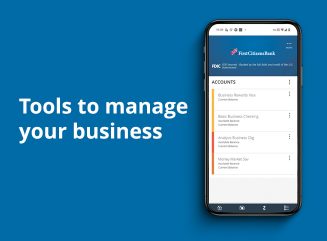
Digital banking for business
Seamlessly access all of your accounts from one place with First Citizens Digital Banking for business.
Learning how to pick the right suppliers is an integral part of business success. Starting a vendor relationship is a major financial decision, and your choice can have long-term implications for your company.

While the role of each vendor will vary, you can both benefit from the partnership if you work together to meet your business needs. Here’s how to kick off the process so you build strong vendor partnerships and ideally end up with the right suppliers and vendors.
If a supplier becomes ingrained in your supply chain, replacing them can be hard and potentially disruptive to business operations. To find the best suppliers for your business, start by carefully mapping out your decision-making process. Here’s how to get started.
You'll want a supplier who can provide what you need at the right price. However, there are other standards to consider, depending on your business strategy.
Work to understand how well a potential supplier relationship can meet the needs of your business stage. Smaller quantities at a reasonable price may be important when starting out. However, when your company hits a growth spurt, you may want a supplier who can pivot quickly to support your scalability. In any case, good suppliers usually have an established reputation within their customer base for delivering as promised.
Gather as much information as possible about the vendor's financial picture. Look for reasonable evidence of healthy credit and cash flow. Companies can go out of business quickly or be unable to purchase from their supply chain. If this happens to your supplier, your business may have to scramble to find the right materials to fulfill customer orders.
A good supplier-manufacturer relationship is built on trust. Open communication builds this trust, which is why it's vital for suppliers to be transparent about their ability to meet your expectations. At a minimum, you should be able to rely on your trading partners to maintain accurate and updated record-keeping systems, regardless of the technology they use.
It may be worth the effort to find a vendor who's willing and able to employ innovative technology solutions to optimize information sharing and increase supply chain visibility. A supplier that fits well into the ecosystems of your distributors, regulatory agencies and market competitors can be a strong long-term partner.
A vendor's commitment to relevant standards and laws can impact your brand reputation, along with your standing with regulators. Research specifications and requirements that are appropriate for your industry. Discuss with prospective suppliers how they handle and document quality concerns, including known quality issues, defect classifications and performance standards.
Look for evidence of quality control, compliance and ethics through licensing, accreditation, previous testing reports and certificates. A site visit or independent product testing of a supplier's samples can provide further insight. If you're planning to import, quality suppliers should expect and be willing to comply with requests for independent verification of goods before shipment.
You'll also want to consider other components of successful vendor relationships as they align with your business needs, which may include:
Once you determine the must-have and nice-to-have vendor qualities, consider issuing a structured bid process. Requests for proposals, or RFPs, can help you manage your decision by communicating and organizing your company's search for materials or services. Vendors hoping to win your business will submit proposals with the documentation and information you need to review. A solid RFP response would be at least three to four qualified bidders with competitive bids.
Compose an RFP like you're writing a job description. Include the capabilities and credentials you want to see in successful vendor candidates. Ask for the most information to help you make an informed choice. If you plan to require a site visit or independent testing, state that in the RFP. Set clear expectations by providing information on timelines, benchmarks and the review process.
As you create the RFP, determine how you'll organize and evaluate the bid submissions. For instance, which factors from your list of vendor criteria will take top priority for shortlisting candidates? Some manufacturers may hold a qualifying round in which bidders have to submit their documentation. The next round could involve testing, site visits or other evaluations.
Also consider how you'll monitor the performance of the winning supplier. Savvy vendor relationship management involves letting vendors know how you plan to assess the ongoing relationship.
Establishing strategies like these early on may help you conduct a more effective RFP process that avoids wasting time and money on all sides. It can also illustrate how well-established your business management style is, which may help make a stronger impression of stability and trust for your vendors. This effort at professionalism can go a long way toward catching the eye of top-quality vendors and other potential business connections.
Email Us
Please select the option that best matches your needs.
Customers with account-related questions who aren't enrolled in Digital Banking or who would prefer to talk with someone can call us directly.